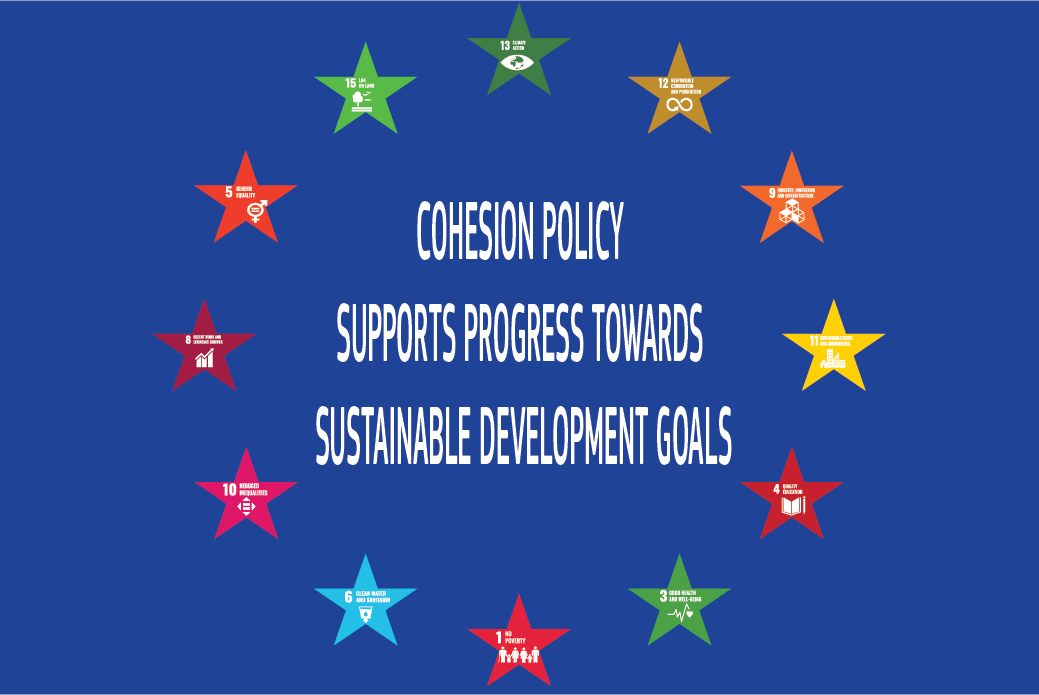Panorama
Cohesion policy supports progress towards sustainable development goals
- 19 Jun 2024
From high-speed broadband networks in France, converting food waste in Italy, eco-villages in the Netherlands, to a homeless shelter in Poland, cohesion policy is contributing to meeting the UN’s 17 sustainable development goals (SDGs).
Adopted by all UN members in 2015, the UN 2030 agenda for sustainable development aims to achieve continuous improvement in quality of life, without compromising the well-being of future generations. This entails balancing economic progress with safeguarding the natural environment and promoting social justice.
The EU is committed to the agenda. The von der Leyen Commission has made sustainability an overriding priority for its 2019-2024 mandate. As all of the SDGs feature in one or more of the six Commission priorities for the period, all of the Commission’s work contributes to achieving them.
In the 2021-2027 programming period, cohesion policy provides direct support to the achievement of 12 of the goals – up from 11 in 2014-2020. The policy now has a direct impact on SDG 5: gender equality – and indirect support on others, notably SDG 10: reduced inequality. Moreover, 94 % of cohesion policy resources directly contribute to reaching the SDGs.
Industry, innovation and infrastructure
In 2021-2027, cohesion policy is allocating the biggest share of its SDG-related resources to SDG 9: industry, innovation and infrastructure: 28 % or EUR 105 billion – similar to the corresponding amount for 2014-2020. Among the main intervention areas are clean urban transport infrastructure and research and innovation in SMEs, both of which account for 8 % of SDG 9-related funding.
Another area linked to SDG 9 for which funding is allocated is broadband deployment. In the French region of Brittany, 500 000 households and businesses now have access to high-speed broadband, largely thanks to the Bretagne Très Haut Débit project. A total of EUR 1.7 billion has been invested to provide the entire region with very-high-speed broadband by 2026.
The project is contributing to economic growth by enabling SMEs to tap into new markets and fostering business innovation and competitiveness. It is also bridging the digital divide, based on the principle that for each new broadband connection in an urban area, one should be established in a rural area. In rural parts of Brittany’s Finistère department, 6 000-7 000 connections are being set up each month, amounting to more than 184 000 so far.
Protecting the planet
A total of 12 % of SDG-related cohesion policy funding for 2021-2027 – over EUR 45 billion – is allocated to activities related to SDGs 11: sustainable cities and communities; 12: responsible consumption and production; 13: climate action; and 15: life on land. This constitutes a sizeable increase from 2014-2020, when the corresponding figures were 7 %, or EUR 27 billion. Key areas of intervention include prevention and management of floods and landslides, nature and biodiversity protection, household waste management and development of cycling infrastructure.
A specific action to boost sustainability involves cohesion policy support for Italian company Tersan Puglia. Its plant can transform, via natural processes, 100 000 tonnes of food waste a year into two essential products: bio-based fertiliser that keeps soil healthy, making it possible to grow food; and biogas, from which renewable methane is extracted and fed into the national energy distribution network. Tersan’s research and development activities have created jobs, with 20 people hired recently.
Another example is Boekel, an award-winning eco-village in the Netherlands, which aims for self-sufficiency in food, water and energy. The community of around 50 people grows its own fruit and vegetables, while its 36 flats are built with sustainable materials like wood and hemp, which absorb CO2. Energy generated by Boekel’s 600 solar panels is stored by the village’s emission-free heating system and used to heat the homes.
Reducing inequality
Concerning social aspects, cohesion policy helps to tackle inequality at all levels – be it between countries, genders or social groups. At regional level, it does this by supporting projects that are aligned with local strategies and priorities and involve a wide range of local stakeholders. Such actions generate dynamism, attract investment, and create opportunities for everyone. To enable regions to make the most of these opportunities, cohesion policy also strengthens local and regional institutions.
In terms of relevant SDGs, funding for actions on SDGs 1: no poverty; 3: good health and well-being; 4: quality education; 5: gender equality; 6: clean water and sanitation; and 8: decent work and economic growth, stands at over EUR 180 billion or 48 % of SDG-related resources for 2021-2027. Among the main areas targeted by the investments are equal access to employment, health infrastructure, primary and secondary education, wastewater collection and treatment and SME business development and internationalisation.
One place where cohesion policy is making a difference is Sisak-Moslavina County, Croatia, which has become a video gaming hub. Thanks to the PISMO project, the town of Novska has two video gaming incubators, which have helped 67 companies and start-ups, almost three times the number envisaged. Examples include Grow, which has created smart glasses that convert sound into text on the lenses for people with hearing impairments, and Hiroma, which develops educational video games for children. PISMO also runs a four-year video game production course and game-making workshops and English lessons for school students.
A further place that has benefited is Włocławek, Poland, where a shelter for the homeless has been extended and its services expanded. People staying at the shelter now have access to health and social services, which is vital given the increasing number of sick and elderly people and people with disabilities among the homeless, as well as the overcrowding in existing shelters in the area.
More information
Find out more
https://cohesiondata.ec.europa.eu/stories/s/21-27-support-to-the-UN-SDGs/uf4a-6qqa
https://www.youtube.com/watch?v=MFmcKGlkvHc
https://www.euronews.com/my-europe/2022/04/25/the-croatian-incubators-hatching-video-gaming-startups
https://kohesio.ec.europa.eu/en/projects/Q2699285
https://open.spotify.com/episode/5NwZhhafcE4A7pe0LZNIJ0

